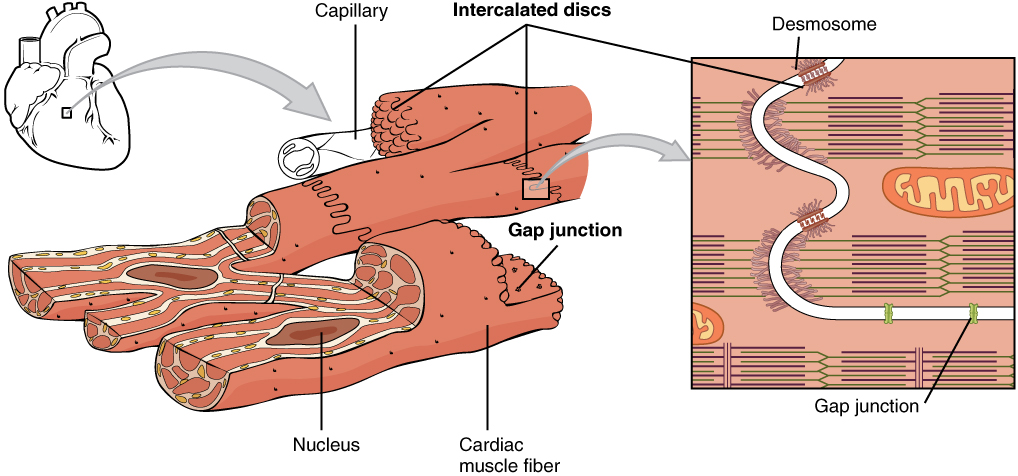What Best Describes Cardiac Muscle Tissue
Striated voluntary slow contraction B. Single nucleus and spindle-shaped cells.

Cardiac Muscle Tissue Anatomy And Physiology
Multinucleate and long cylindrical cells b.

. It makes up the tissue called the myocardium. Muscle tissue that maintains posture body position and stabilizes joints. Involuntary movement and cell striation.
Cardiac muscle tissue also known as myocardium is a structurally and functionally unique subtype of muscle tissue located in the heart that actually has characteristics from both skeletal and muscle tissues. None of the above. Muscle tissue that activates arrector pili muscles to stand hairs on.
Which phrase best describes the tough connective tissue. What type of muscle is found in the walls of hollow organs such as the stomach and in the walls of blood vessels. Multinucleate and long cylindrical cells.
The cells in cardiac muscle tissue work together to the heart muscle contract. Which statement best describes cardiac muscle. Cardiac muscle cells have an irregular branched appearance that are shorter than the longer cylindrical cells found in skeletal muscle tissue and different from the fusiform shape of smooth muscle.
Cardiac muscle tissue is only found in your. Cardiac muscle tissue is one of the three types of muscle tissue in your body. Cardiac muscle tissue is made up of muscle cells which are a.
This muscle tissue which contracts. Anatomy and Physiology 1. The cells in cardiac muscle tissue work together to the heart muscle contract.
Which of these characteristics best describes cardiac muscle tissue. Smooth muscle tissue contraction is responsible for involuntary movements in the internal organs. Which of the following best describes cardiac muscle.
3 It is connected to bones and makes up the bulk of the heart. Cardiac muscle is striated muscle that is present only in the heart. Cardiac muscle tissue relies mainly on aerobic respiration.
Attached cells form long branching cardiac muscle fibers that act as a syncytium allowing the cells to synchronize their actions. A person cannot control it consciously. Cardiac muscle tissue is found throughout the body carrying out a wide variety of functions for the organism.
The ring of muscle tissue that controls the pupils size is called the. Muscle tissue that activates arrector pili muscles to stand hairs on end. Which shape best describes cardiac muscle cells.
Which of these characteristics best describes cardiac muscle tissue. It forms the contractile component. 1 It is striated and voluntary in action.
View Cardiac Muscle Tissue Quizdocx from BIO 104 at Western Governors University. Choice B B Cardiac muscle tissue is found throughout the body carrying out a wide variety of functions for the organism. Striated involuntary intercalated discs.
_____ is a connective tissue element that makes muscle extensible and elastic. My Classes MULTIPLE CHOICE QUESTION Which of the following best describes cardiac muscle tissue. Which of these characteristics best describes cardiac muscle tissue.
Also it is a striped muscle in the walls of the heart. Which best describes motor unit recruitments function. Cardiac muscle tissue is found throughout the body carrying out a wide variety of functions for the organism.
Branching not striated voluntary Branching involuntary striated Non-branching striated involuntary Non-branching not. The other types of muscle are the skeletal and smooth muscle. What type of tissue forms tendons and ligaments.
Troponin is a regulatory protein in A. Movement is voluntary and cells possess striations c. Which shape best describes cardiac muscle cells.
Muscle tissue conducts nerve impulses from one neuron to another and coordinates body activities. Choice C C Cardiac muscle tissue is made up of muscle cells which are a type of specialized cell. Which of these characteristics best describes cardiac muscle tissue.
Cardiac muscle tissue is made up of muscle cells which are a type of specialized cell. It is capable of strong continuous and rhythmic contractions that are automatically generated. Cardiac Muscle Tissue Reticular Connective Tissue Terms in this set 35 areolar tissue loose connective tissue simple squamous epithelial alveoli skeletal muscle dense fibrosis connective tissue tendon simple columnar small intestines cardiac muscle which type of tissue conducts electrochemical impulses nervous tissue.
Attached to the skeleton e. Cardiac muscle tissue or myocardium is a specialized type of muscle tissue that forms the heart. The other two types are skeletal muscle tissue and smooth muscle tissue.
2 It is striated and involuntary in action. Cardiac Muscle Tissue Quiz. Single nucleus and spindle-shaped cells d.
_____ muscle tissue has no visible striations and has spindle-shaped cells. This protects the muscle and helps it return to its resting length. The cardiac muscle pumps blood through the body and is under involuntary control.
Movement is involuntary and cells possess striations Which type of epithelial tissue is found lining the kidney tubules. A prevents muscle fatigue B inhibits muscle strength C prevents complete tetanus D contributes to creating smooth movements. Which of these characteristics best describe cardiac muscle tissue Movement is involuntary and cells possess striations The type of muscle found in the walls of hollow organs such as the stomach and in the walls of the blood vessels is.
Cardiac muscle heart muscle is one of the three main types of muscle in vertebrates. 4 It is a structural component of both the digestive tract and the heart. The answer is b branched.
Cardiac muscle fibers have a single nucleus are branched and joined to one another by intercalated discs that contain gap junctions for depolarization between cells and desmosomes to hold the fibers together when the heart contracts.
:background_color(FFFFFF):format(jpeg)/images/library/13939/LNOsY5VQ7ADcaM1g9m5g_Cardiac_Muscle.png)
Cardiac Muscle Tissue Histology Kenhub

Cardiac Muscle Definition Function Structure Britannica

A Cardiac Muscle Cells Have Myofibrils Composed Of Myofilaments Arranged In Sarcomeres T Tubules To Transmit The Impu Cardiac Muscle Cell Physiology Cardiac
No comments for "What Best Describes Cardiac Muscle Tissue"
Post a Comment